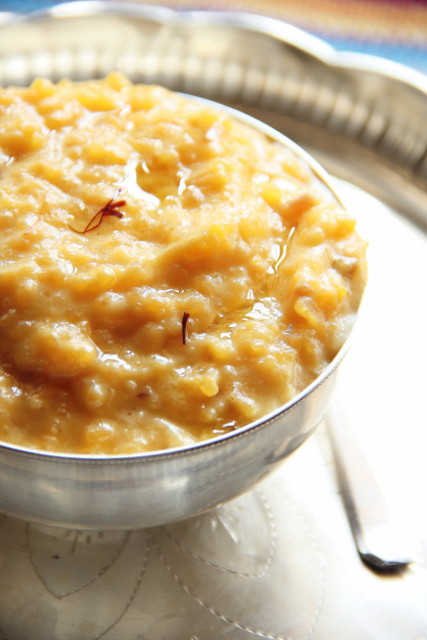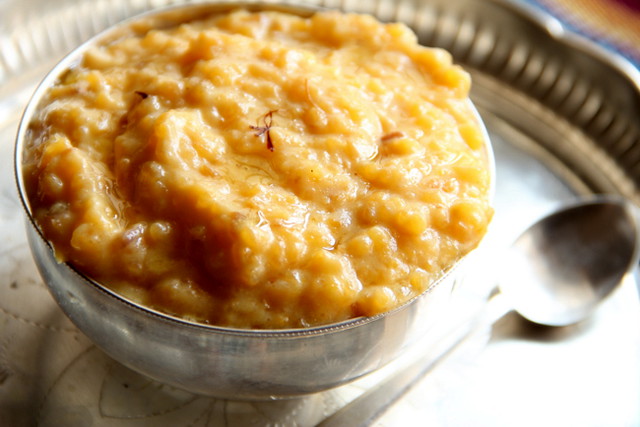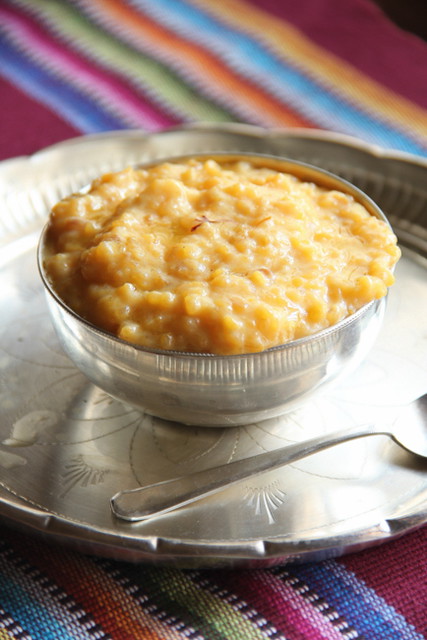
Tamil Nadu! The land of ancient culture and temple amuses anyone with the variety of divine sweets, being offered to God on auspicious occasions. Akkaravadisal is a preparation made almost like pal pongal or sakkarai pongal or to be precise it falls right in between the two, belonging to the Pongal family!
Akkaravadisal is offered to God ( Maha Vishnu?) for Koodaravalli.
This is a tried and tested recipe of the sweet, primarily cooked in a pressure cooker and then in a non stick kadai, a practical substitution to the traditional bronze pot method.
Akkaravadisal / Rice and dal milk pudding
Raw rice / Pacharisi - 1 cupMoong dal / Pasi parupu - 1/2 cup
Milk - 1 1/2 litres ( separate to two parts 3 1/2 cups and 2 1/2 cups )
*Sugar - 1 1/2 cups- 2 cups ( as per your sweet level)
Ghee - 2 tbsp
Almonds or cashews and raisins - to garnish
Dry roast moong dal in a kadai till light brown. Remove from the kadai. Let it cool and give a quick rinse.
Transferwashed rice and dal into a vessel which in turn is placed in a pressure cooker [do not transfer to the body but to a tall and broad container which sits in cooker ( that contains water) comfortably] Pour 3 1/2 cups of milk and stir. Close the lid and pressure cook until 6 whistles. Lowering the flame after the first whistle.
Open after the steam vents off by itself. Boil the 2 1/2 cups of remaining milk.
Mash the rice and dal (drain aside excess milk if any) and transfer to a non stick kadai.
Add sugar and pinch of edible yellow food colour (dissoved in a tsp of water) and simmer the rice dal mixture adding the 2 1/2 cups of milk ( and the earlier drained milk if any) until the right consistency is reached. Stir in ghee towards the end just to make the sweet moist and richer. Top with saffron strands.
Roasted nuts and raisins are the suggested garnishings, though I don't use them.
Note:
The 3.5 cups of milk you use to cook the rice and dal need not be boiled. It can be raw low fat milk.
Rice n dal don't cook mushy in full fat milk or milk in general. So 6 whistles, at least, is a must.
Newly harvested rice doesn't absorb milk much, but age old rice does! So know your raw rice better before you add milk in both the stages. The division can be either 4 plus 2 instead of 3.5 plus 2.5. Adjust a bit accordingly!
Direct cooking in a pressure cooker body, however large it is, will let milk boil over through the vent and creates mess. So, use a separate container, which is tall enough, placed in the cooker.The rice, dal and milk all should be filled only till half of this vessel.This is to allow space, in the safer side, for the milk to boil when rice and dal is cooked. Select a big cooker for the purpose. Use sufficient amount of water in the cooker as it takes a longer time to cook.
*Traditionally akkarivadisal made with 2 or even 2 1/2 cups of sugar according to the rice n dal measurements in the above recipe. I personally like less sweeter and used 1 1/2 cups.
The authentic way of making akkaravadisal is like making pongal, in a bronze pot with fire wood which imparts the real flavour to the divine sweet! Yet the authentic flavour of akkaravadisal is brought to the nearest in this recipe!





I love this..eaten it many times at a friend's place.
ReplyDeletewow.... that was yummy.... I personally feel what ever that is given in temple like puliyodhurai, sakkarai pongal really have an extra taste always...
ReplyDeleteWow!!!looks so delicious and creamy,tempting clicks....
ReplyDeletewish you a happy new year.
ReplyDeleteAkkaravadisil, kalkandu sadham and such are truly divine dishes and you have one in a bowl here that will welcome the Gods to partake.
Looks creamy and yum
ReplyDeletelooks really delicious!
ReplyDeletei have only heard of these in a couple of old Visu movies :D brings back memories!!
ReplyDeleteLove the silver platter and bowl.The pics are quite tempting but know what-I've tasted this once and find it too sweet for my palate.Is it only me or is it supposed to be that sweet?
ReplyDeleteSuper yum it looks, tempted me a lot, will make very soon and have ;) Nice recipe
ReplyDeleteNever been bored of eating this delicious dish..
ReplyDeleteLooks absolutely divine.
ReplyDeletewow...tempting and delicious food...
ReplyDeleteBrilliant stuff!
ReplyDeletechennaiflowerplaza.com
My MIL makes it during many festivals..love the creamy texture of this dessert. Lovely clicks, Bharathy.
ReplyDeleteLite Bite
I have never tried this before but I sure would like to now... Thanks for sharing the recipe!
ReplyDeleteThe last time I had this at some koil, I was thinking it is sakkaraipongal and ate! When informed later, I was kinda blah about it.To confuse further, The Mahavishnu seems to like both.
ReplyDeleteNice pictures and lovely presentation. While, pressure cooking is great for time saving, it never tastes quite as good as slow-cooking on the stove top. So I now use slow-cooker for making this, as you mention, for kudaravalli. It does not cut down the time, but, it definitely cuts down the effort involved without compromising the taste :)
ReplyDeletevery useful really good information thanks for posting such a good information it will hepls the people a lot keep it up , Regards,
ReplyDeletechakkara pongal recipe